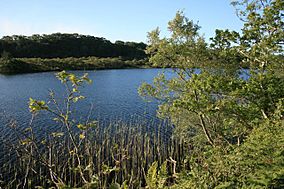Taynish National Nature Reserve facts for kids
Quick facts for kids Taynish National Nature Reserve |
|
|---|---|
|
IUCN Category II (National Park)
|
|

Lochan Taynish
|
|
| Location | Tayvallich, Argyll and Bute, Scotland |
| Area | 370 ha (910 acres) |
| Established | 1977 |
| Governing body | NatureScot |
| Taynish National Nature Reserve | |
The Taynish National Nature Reserve (which is Tèarmann Nàdair Nàiseanta Taighnis in Scottish Gaelic) is a special natural area in Scotland. You can find it southwest of the village of Tayvallich in Argyll and Bute.
This reserve covers almost the whole Taynish peninsula. This land stretches about 5 kilometers (3 miles) long and 1 kilometer (0.6 miles) wide. The woodlands here are often called a 'temperate rainforest'. This is because they get a lot of rain and have a mild climate. This weather is thanks to the Gulf Stream, a warm ocean current.
NatureScot owns and looks after Taynish. It became a National Nature Reserve (NNR) in 1977. This means it's a protected place for wildlife and nature.
NatureScot has made it easy for visitors to explore. There's a car park and three marked walking trails. These are the Barr Mòr Trail, the Woodland Trail, and the Coastal Trail. In 2015, about 9,500 people visited the reserve each year.
Contents
What Plants Grow at Taynish?
About three-quarters of Taynish National Nature Reserve is covered in trees. Most of these are old sessile oak trees. You can also find smaller areas of birch, alder, and ash trees.
In the 1800s, people used to manage these woods. They would cut trees to make charcoal and to get oak bark. Oak bark was used in the tanning industry to make leather. They used a method called coppicing, which helps trees regrow. This also made sure oak trees grew more than other types of trees.
Mosses, Lichens, and Other Plants
The warm, wet weather at Taynish is perfect for many small plants. You'll find lots of ferns, mosses, and liverworts here. Over 250 different kinds of mosses and liverworts have been found.
Taynish is also home to many lichen species. Scientists have recorded 475 different types of lichens. This includes 91 species that are rare in the UK. Another special plant here is the narrow-leaved helleborine. This is a type of orchid that is important for conservation.
What Animals Live at Taynish?
Taynish National Nature Reserve has many different habitats. This means it's a great home for a huge number of insects and other small creatures. You can find butterflies, dragonflies, moths, and beetles.
Butterflies and Moths
One very special butterfly found here is the marsh fritillary. This butterfly is one of the most endangered in Europe. The reserve also has 450 different kinds of moths. Thirteen species of dragonfly also live here.
Mammals and Birds
Taynish is a good place to see otters. They are often seen looking for food near the shore. Other mammals living here include red squirrels, pipistrelle bats, and a small number of deer.
The mix of woodlands and other habitats makes Taynish a great place for birds to breed. Many different bird species live here. Some important ones include the reed bunting, spotted flycatcher, skylark, bullfinch, linnet, and song thrush. Large birds like golden eagles, sea eagles, and osprey have also been seen flying over the Taynish peninsula.
Why Taynish is Protected
Taynish National Nature Reserve is a very important place for nature. It is listed as a Category II protected area by the International Union for Conservation of Nature (IUCN). This means it's a national park or a similar protected area.
Besides being a National Nature Reserve, Taynish has other special protections. It is a Site of Special Scientific Interest (SSSI) called Taynish Woods. It is also part of the Taynish and Knapdale Woods Special Area of Conservation (SAC). This means it's important for protecting certain habitats and species in Europe. Taynish is also located within the beautiful Knapdale National Scenic Area.


